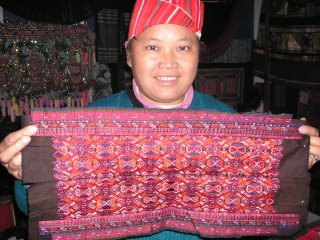

I marveled at this work and resisted the impulse to add pieces to my collection -- except for a batik-ed dragon. Besides displays of thisintricate work many women, both young and older women wore their traditional costumes. Chinese authorities understand that tourists to the area prefer to see "authentic" costumes when they visit the villages. They're learning to commercialize the tribal peoples and likewise the tribal people are learning to sell to the tourists.
Many natural sitesin the area have been "improved" for tourists. I'll write more about some of them in subsequent days. I'll get to the "adventure" part in a bit. On the subject of selling to tourists, the Chinese government is talking advntage of the romance of James Hilton's book, LOST HORIZON, and actually renamed a Western part of Yunnan province -- which is the eastern most reaches of the Himalayan chain and is 2-1/2 miles high, "SHAMBALA". For those who are unfamiliar with Hilton's book, it is about an Englishman who finds himself in a high mountain valley and is taken to a hidden monastery where advanced monks have learned many secrets including eternal life. The book was popular in the 40s and made into a movie with Ronald Coleman. It's a fantasy, of course, feeding the cult of Tibetan magic and mystery. Shambala has long existed as metaphor - a mountain bound Eden. Now it has been added to the official map of China. .
Shambala was the last stop on our itiinerary, We left mile high Lijiang [a beautiful city about which I will write another time] and climbed past Tiger Leaping Gorge, the deepest gorge of the Yangtze River. We had just arrived in the Tibetan area which was 14,000 feet up a brilliantly engineered road that had been open only a few months. A beautiful group of children appeared beside the road and we stopped to photograph and talk to them. Within a single moment my budding experience of the magic of Shambala turned to "adventure" [perhaps trauma is the word]. In jumping up a little embankment to the children, I fell ... entirely on my left hip. And displaced it. And fractured it.
Thus ended my vacation and began my adventure getting home. Steps in the process: x-ray at the local hospital and a prescription for green and white capsules, contents unknown [I think it was morphine] upon which I was acutely dependent for the next 30 hours. Overnight in Shambala, a short plane to Kunming, a longer plane to Beijing. The good luck of getting on a Continental bound for Newark instead of having to overnight in Beijing. An ambulance to NJ hospital, another ambulance to a NYC hospital. Eventually a total hip replacement. Now I'm home, walking, feeling okay and facing several weeks of regaining full mobility.
The medical part of the story is mundane. One of the morals of this story is that I'm happy I was on a trip arranged by Snow Lion Expeditions and that the American guide, Jeff Grinnell, was along. He had smoothed many minor bumps between our desires to see "real" people and the Chinese-supplied local guides who were prepared only to show us the official sites. He is also a seasoned trekking guide and had just come from guiding people to Everest base camp and above. He was the level headed, competant, knowledgeable sort and I was enormously lucky to have him there. He did all the right things, medically and helped tremendously with the changes of tickets to get me home. I cannot conceive how I might has coped without him.

The above picture is a Miaou bridge - a powerful symbol in their belief system we were told. Bridges are powerful symbols for all of us. This trip was a bridge for me. I had hoped to trek on Katchenjenga, the third highest mountain in the world, but decided I'm too old to tackle it; so I turned to my ever increasing interest in textiles and chose to go to Yunnan, but was feeding my fascination with the Tibetan/Shambala wonders too. No sooner did I reach an altitude higher than any in the USA, than I crashed. I feel like Icarus when I think of it that way. So this trip serves as a turning point. I have to regain my mobility in the next several weeks and I have to assess where crossing this bridge has taken me.







No comments :
Post a Comment